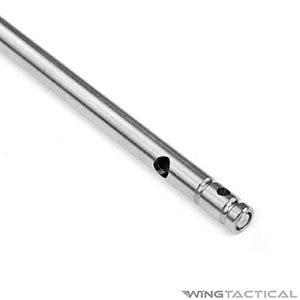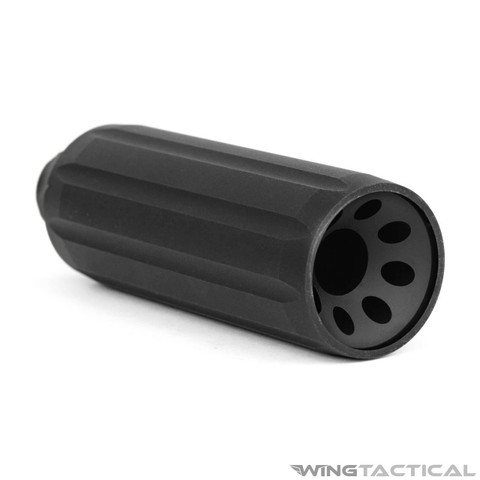Depending on the length and intended use of your AR system, you will need to choose appropriate gas system parts. A basic weekend range system or home defense setup is a very different creature from an ultralight competition rifle. Specialized AR gas system components are available for every shooter's needs, and Wing Tactical offers many of the best. Your system's efficiency and ability to cycle properly depend on the proper function of your gas system.

AR Gas Systems: A Customization Opportunity
The AR-15 rifle is a gas-operated weapon system that relies on the pressure of gasses created and expelled on firing to make the system cycle.
In a gas impingement system, the primer ignites the powder inside the casing creating an explosive reaction that produces heat and pressure. Hot gasses force the bullet from the casing neck down the barrel. The energy and pressure created by that explosion not only propel the projectile downrange but, when properly harnessed, operate the system through the following cycle:
The gas block captures a share of the pressurized gasses and sends them back through the gas tube to a key port in the bolt carrier group. This forces the bolt carrier group backward. As the bolt carrier group retreats, the spent shell is ejected and replaced as the bolt carrier group returns to its starting position.

Gas Blocks
Gas blocks are key to any AR gas system. A basic gas block functions as a gathering and routing station for gasses expelled through a small hole in the AR-15 rifle barrel. There are several different styles and profiles of gas blocks, but they have the same goal: collect gasses from the barrel and send them back to the bolt carrier group by releasing them through the gas tube attached to the block.

Gas Tubes
The gas tube in an AR-15 gas impingement system attaches to the gas block at one end and the gas key at the other. It provides a secure path for gasses to travel back to force the bolt carrier group to cycle.

Gas Keys
The gas key is a fitting which the gas tube attaches to. It allows the gasses forced back from the barrel and gas block to enter the receiver and cycle the bolt carrier group.
Shop AR Gas System Parts with Wing Tactical
The team at Wing Tactical is here to help. We partner with only the best manufacturers in the industry. Choose an adjustable gas block, low profile gas block, or even an ultra-light titanium gas block: Wing Tactical has them all and so many more. You might need help to choose.
Don’t hesitate to contact our customer service department. Our site is staffed by people who are familiar with the products we sell. They are operators and armorers just like you, and they’re happy to help you choose the right gas system parts so that you can truly give yourself an edge with products from Wing Tactical.
Frequently Asked Questions
Which types of gas blocks are available?
There are many different gas block offerings for the AR platform, each offering a unique solution. Gas blocks are commonly available in forward site base, normal height, low profile, or adjustable varieties:
- Forward Sight Base – These high-volume gas blocks feature an integrated forward sight base and often a sling swivel. It’s an old-school, familiar design for those who are accustomed to military-style setups.
- Normal Height – Normal height gas blocks are usually high-volume gas blocks. These gas blocks often limit the shooter to a shorter handguard since they are tough to fit under a forend.
- Low Profile – These are compact gas blocks that are designed to fit under handguards. These are often lightweight or adjustable, as well as being smaller than standard height gas blocks. The smallest among these offerings may be labeled as “micro gas blocks.”
- Adjustable – Adjustable AR gas blocks are often used by precision shooters to tune their gas systems. Gas tuning allows the shooter to maximize the performance of his system while controlling the negative effects of over-gassing. Precision gas tuning is also a practice of shooters who may use different types of ammunition or compete at different elevations, as changes in gas pressure can affect performance in both cases.
Which gas tube length is right for my AR?
Aside from the diameter of your gas tube, the only other real concern in fitting the gas tube for your AR-15 system is length. You can choose from four common lengths of gas tubes: pistol, carbine, mid-length, and full/rifle-length gas tubes are readily available from Wing Tactical.
In a pistol-length system, the distance between the receiver key and the gas block is four inches. A carbine system is seven inches. A mid-length is 9 inches, and a full-length rifle gas tube is twelve inches. It is worth noting that the overall barrel length of a system may vary, but these gas system measurements remain consistent.
How do I know if my AR is under-gassed?
Both under-gassing and over-gassing can result in cycling issues for the AR platform. If your AR is under-gassed, your casing might eject too slowly, jamming the rifle and preventing cycling. But, before tinkering with the gas system, make sure that your ammunition isn’t the culprit—not all brands, bullet types, and casing materials cycle perfectly in all actions.
Is my AR over-gassed?
If your AR is over-gassed, you might experience cycling issues like:
- Failure to extract
- Failure to feed
- Erratic extraction
You might also experience increased felt recoil. Over-gassing can result in faster-than-average wear and tear on your bolt and other action parts, so be sure to resolve over-gassing issues as soon as possible.
Why is my AR-15 not cycling correctly?
If your AR-15 isn’t cycling properly, is cycling too slowly, or cycling erratically (not according to a predictable pattern), you could have any number of issues, like:
- Over-gassing or under-gassing
- Misaligned action components
- Wear and tear on your bolt
- A malfunctioning buffer tube or gas components
But, your cycling issues could also be attributed to your ammunition. Before disassembling your firearm, try a few rounds of a different brand with a different casing material or bullet type or material. If your rifle still doesn’t cycle correctly, you may have a mechanical problem.






